WHEN A PARIS PÉNICHE IS MORE THAN JUST A BARGE
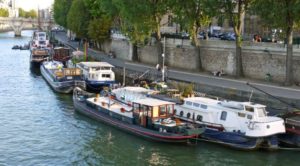
One of the most pleasant ways to relax in Paris is to take a stroll along the banks of the Seine. It’s a busy, working river with a constant flow of craft of all descriptions. Ranging from the many tourist boats crammed with sightseers enjoying the unique perspective of the city’s great landmarks from the river, to serious, business-like barges riding low in the water, filled with anything from building site rubble to bales of shredded paper heading to the recycling depot, while others are piled high with freight. Many also have homey touches such as pot plants, plastic garden furniture, laundry fluttering in the breeze, and perhaps a small car and bicycles perched on the back deck. As well, there are other barges, tied up dockside, that are clearly used as floating homes. Aside from these though, there are a number of traditional barges, or péniches, that have been converted to quite different uses.
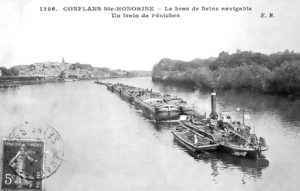
Barges, both on canals and rivers, have played a major role in France’s economy for centuries. The Romans used barges across the Empire, and created canals in sections of some rivers to make them more navigable, such as the Canal de la Robine, which flows through Narbonne in the South of France, which was built along a portion of the River Aude. The River Seine has been a water highway connecting people and goods across France for centuries. Even before the arrival of the Romans, a stream of commerce made its way along the Seine, coming up from the Mediterranean through the Rhone Valley. In 1950 it was reckoned that there were about 15,000 barge men on the Seine. Today, only 1,000 are left.
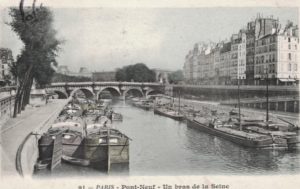
Historically, the Seine was everything to Paris, and river transport was regarded as more reliable than by land. Barges brought essential merchandise and produce from the distant provinces. Dating from the 16th century, river barges were typically flat-bottomed, wide boats either punted or pulled by animals, and sometimes even towed or pushed along by other, smaller boats. Often, they made a single voyage to Paris, to be dismantled on the spot and sold as timber. One embankment specialised in wheat, while another was dedicated to the wine trade.
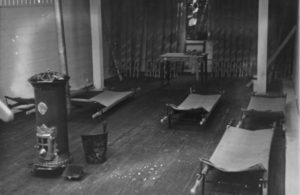
During WWl, péniches served as more than just freight carriers. Some were pressed into service as floating ambulances as early as October 1914 with very basic amenities, and as hospitals a little later in the war. Le Union des Femmes de France fitted out some of these péniches with more comfortable accommodation for wounded soldiers.
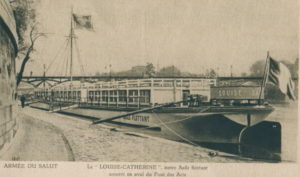
Some barges met unexpected fates. The Louise-Catherine, originally named Liege, was built in 1915 to transport coal. It was transformed in 1929 by the iconic Modernist architect, Le Corbusier, into a homeless shelter for the Salvation Army. After decades of service it sank due to unprecedented rainfall on 08 February 2018. The city experienced some of the heaviest rains it had seen in 50 years. The Seine flooded its banks, submerging parks, streets and disrupted the metro service, and also claimed this architectural curiosity. As the floodwaters receded, the old barge’s bow became stuck on the wharf near Gare d’Austerlitz, tipping it into the river. Sadly, before it sank, the barge was on the verge of receiving a facelift, and had been declared a historic monument in 2008. By all accounts, there are plans to try and re-float the Louise Catherine and continue the restoration.
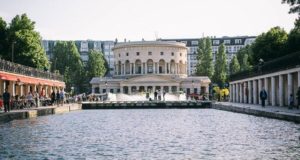
Today, there seems to be as many péniches tied up to the river bank as there are those fulfilling their traditional function transporting goods. They’re moored along the quais of the Seine, under the bridges between the Île de la Cite and Île Saint-Louis, in the canals Saint-Martin and Ourq, and in the Port de l’Arsenal and Bassin de la Villette.
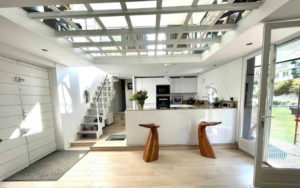
Many of the old barges, known as propeller boats traditionally powered by steam, have become permanent boat-homes, which is certainly an original way of living at the heart of the capital, allowing owners to benefit from one of the most beautiful settings Paris has to offer. Occasionally, these come up for sale and sell for huge prices. Well-appointed former barges of 200m²+ in sought-after locations can sell from around €300,000 for a 50m² péniche to €1.5 million+. A traditional barge can cost around 40% less than a traditional apartment in a good arrondissement.
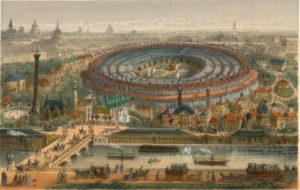
Most of the tourist boats that ply the Seine are run by the Bateaux-Mouches Company. This business started when the owner of a number of working riverboats offered the use of his company’s craft, mostly barges, to transport visitors on trips along the Seine during the 1867 Universal Exhibition. Thirty bateaux-mouches were dispatched to Paris via the river Saone and proved to be a huge success with Parisians and visitors alike, especially after the endorsement of visitors such as Tsar Alexander ll and his two sons, whose doings were related in detail and followed avidly in the tabloids of the time.
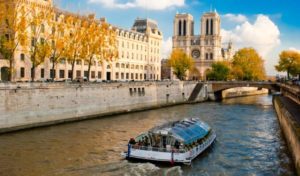
The idea of converting barges for public transport and for the burgeoning tourism industry was born. The opening of the first Paris Metro line linking Porte de Vincennes to Porte Maillot in 1900, sounded the death knell for barges being used for everyday public transport on the Seine, but fortunately, their popularity as a tourist attraction has only increased in the ensuing years. Some of the newer Bateaux-Mouches are now so big that locals have dubbed them “transport de troupes” (troop carriers)!
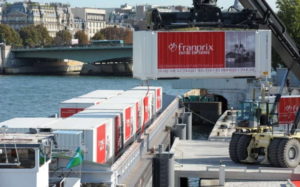
Even though the city’s freight transport by barge had slowed to a trickle, since the 1990s there has been a big increase in the number of barges travelling up the Seine from Le Havre and Rouen, but most of these load and unload well outside the city centre. However, since 2013, leading supermarket chain Franprix has taken the radical step of making a considerable quantity of its Paris deliveries by boat. Every morning, a barge takes around 26 containers upstream at the port of Bonneuil-sur-Marne, a tributary of the Seine. The barge then moves down river and docks at the Porte de la Bourdonnais, a small quai squeezed between the Eiffel Tower and the Musée du Quai Branly.
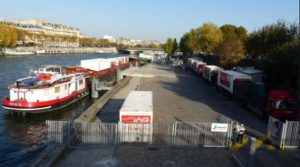
At dawn the next day, trucks pick up the containers and deliver the goods to 135 of its 350 stores around the city, taking more than 2,600 trucks off the city’s congested roads each year. Franprix has calculated that it saves the equivalent of 300,000 km of road transit, almost 9,000 times the length of the city’s Peripherique ring-road. “This is not some marketing gimmick, it is a genuine business decision,” said Laurent Kamiel supply chain director at Franprix. He went on to say that cost-wise, it’s almost the same as taking the containers by road, but adds that they are looking to the future and can see that the way things are going, like most big cities, Paris is going to limit road traffic. “So we think river transport is going to be increasingly attractive.” In due course, Franprix aims to stock most of its Parisian stores via water. An instance of reverting back to historic tradition perhaps.
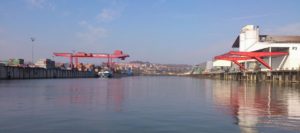
This return to freight deliveries by barge is now being replicated by IKEA, who say that around 30% of orders are now being transported by water. The floating warehouse sails up and down the Seine between the inland Port de Gennevilliers, where IKEA has a distribution centre, and 4 unloading points, from where cargo bikes depart with customers’ goods. Other companies are sure to follow this growing trend in efforts to reduce road traffic, with its associated problems and disadvantages.
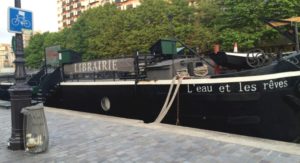
It’s not just floating homes and transport though. One of France’s gigantic canal boats—fitting the lock standardised by the Freycinet Act (1879) of a parallel-piped shape 40m long and 5.20m. wide—is now the Péniche L’Eau et les Rêves (Water and Dreams) bookshop and café, moored alongside Quai de L’Oise just off the Bassin de la Villette, in the 19th arr. Named after a work by philosopher Gaston Bachelard, one of its co-owners says that they had had the idea of a floating bookshop on the theme of water because of the seafaring background of the other owner, and their joint passions for the sea, boats and the world of books.
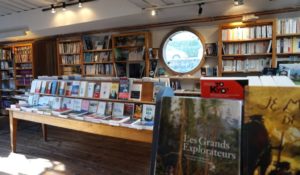
Péniche L’Eau de les Reves has an inevitable nautical theme, replete with portholes, mermaids and old maps. You’ll find beautiful coffee-table books, pocket-sized poetry books, history and literature, but not surprisingly, the specialty is the sea, covering general travel, great voyages and maritime escapades, although it’s still a mainstream bookshop with new titles. There’s a very inviting, secluded area for children’s books, and on deck are a couple of traditional Parisian bouquiniste stands holding second-hand books, and a handy bench overlooking the canal enables you to dive into a new story there and then. There are also spaces for theatre workshops, lectures and book signings. They will also order English language books for you. Their café offers snacks, fresh juices, wine and cocktails.
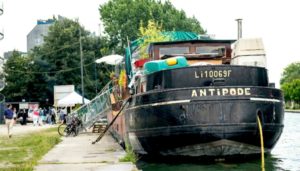
Moored alongside 55 Quai de la Seine near the Bassin de la Villette is the Café Theatre Péniche Antipode. A word usually associated with Australia and the “lands down under”, nevertheless, the dictionary defines ‘antipode’ as “something which is the direct opposite of something else”—and that’s what Antipode is all about. An imposing hulk of a barge, built in Belgium in 1942 during WWll, it transported all manner of cargo along the canals of Europe.
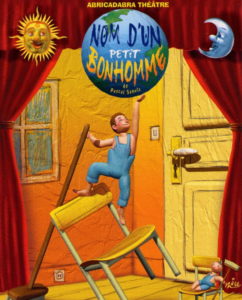
It ceased freight activities in 2002 when it was moored at Bassin de la Villette. Along came Abricadabra (French spelling!), a children’s theatre company, who decided to renovate the old barge, giving it a second lease of life as a cultural venue. Since then, this venue for children’s entertainment—such as puppet shows, mime, acrobatics, comedy and songs—has also offered concerts, shows, cabarets and music events in the evenings for adults, with over 300 events being organised each year. These vary greatly from jazz and reggae through to blues, as well as DJ nights and theatre performances, so there’s always something different on the agenda.
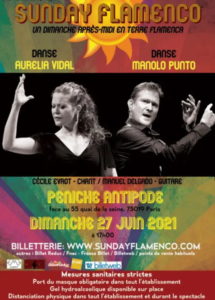
The Péniche Antipode also pride themselves on offering artisanal products that are hand-made rather than being commercially mass produced, plus they also stock a large range of Fair Trade products. The Café Antipode, a bar and restaurant, offers a la carte, fair trade and artisanal foods and a well-stocked bar, but you won’t find any brand names, in keeping with the artisanal, hand-made policy. It’s a buzzing, creative place with great atmosphere, and if you go on Saturday or Sunday mornings, there’s a market right next to it on the quai.
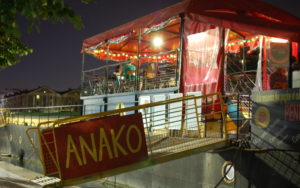
Péniche Anako advertises itself as a cultural centre inviting you to meet other peoples and cultures whom you otherwise might never meet. On offer are world music sessions, African tribal dance classes, gems of old cinema and documentaries on topics as far-ranging as Iranian women, Mumbai’s slums or Amazonian tribes, or perhaps sit in on a conference about Bolivian natural resources or listen to a traditional Chilean concert. The Péniche Anako is named after one of the last survivors of a great Amazonian people, this péniche has a long history with the Armenian Red Cross Relief Committee, who symbolically make the barge available to promote their cause of multiculturalism. Like the Antipode, the vibe is very casual and friendly. They also have a menu of the day. It’s also located at the Bassin de la Villette, facing 34 quai de la Loire, in the 19th arr.
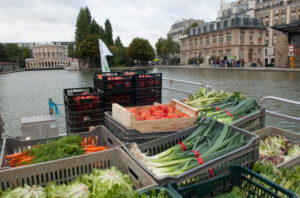
Since 2012, the Marché sur l’Eau (Market on the Water) Association has offered Paris residents the opportunity to buy good quality fresh fruits, vegetables and other food items direct from growers and producers in the Île de France. The boat that’s used for the floating market is Les Deux Brigands, which is docked on Tuesdays and Saturdays in the Bassin de la Villette, behind La Rotonde. It’s a favourite not only with individual residents but also restaurateurs, who appreciate not only the quality of the produce but also the fact that pretty much all of it is organic—even Les Deux Brigands is 100% sustainably fuelled. Everyone is welcome to browse on board or on the quayside, and it’s also possible to pre-order for weekly delivery. All produce is picked when ripe and in season. Other goodies include preserves, honey and craft beers. The easiest way to find the floating market is to first head to Place Stalingrad in the 19th, arr. and from there, you’ll find La Rotonde.
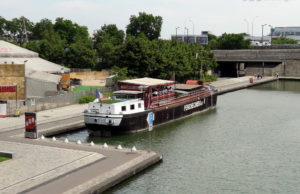
La Péniche Cinéma, the first barge of its kind, whose interior space of 100m² is designed as a mini-cinema, screening short films and documentaries. Even though many of the offerings are award winners, the films ae mostly unknown to the general public. The programming is eclectic, ambitious, and professionally run. In addition, the association operating La Péniche Cinéma offers small festivals and events centred on filmmakers and producers. They also want to serve as a launching pad for the creators of tomorrow, and they even offer intensive filmmaking courses for children. The restaurant, ‘La Terrasse de Frankie’, located on the bridge, features homemade, seasonal cuisine and craft beers for moviegoers looking for a post-movie snack, with seating capacity for 80 people and a terrace of 40m² with space for 40. You’ll find the barge at Canal de l’Ourcq, in the Parc de la Villette, facing the ‘Cabaret Sauvage’, 59 Bvd MacDonald, in the 19th arr. It’s open all year round except during August.
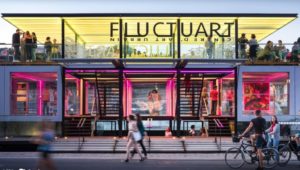
Fluctuart is a floating urban arts centre, located at the foot of the Pont des Invalides, at Port du Gros Caillou, in the 7th arr. Fluctuart features works by internationally renowned street and graffiti artists like Banksy, Keith Haring, JR and Shepard Airey. Fluctuart is a totally different take on the idea of a traditional museum by creating an opportunity to see urban art in a Seine-side setting. This large barge of 1,000m² consists of three galley spaces connected from water to rooftop by a series of atrium-like gangways which create an intimate link between the river and gallery-goers. It’s free and open from noon to midnight, and enthusiastic staff offer tours of the spaces. The bookshop specialises in books and prints related to urban culture, and the café offers a small, imaginative menu. In the evening, you’re invited to stay and listen to music, enjoy a cocktail, take in some very interesting art and views of the Seine.

The Jardin Flottant de l’Archipel des Berges de Seine – Niki de Saint-Phalle, are five unique gardens growing on a series of custom built metal barges, and named in honour of a French-American sculptor. Permanently moored and strung together, these small island “parks” total 1800m², and designed to evoke the microclimates found along the Seine. The barges consist of a bird island with flowering shrubs and those with berries in which birds can make their nests; there’s a prairie island with field flowers and tall grasses, while the central island has child-friendly rope nets on which children are encouraged to climb, and an orchard island. In the bow of the front barge is the l’île aux brumes (misty island), where mechanical fog equipment replicates the often mysterious quality of the banks of the Seine. This whole concept is a pedestrian oasis of biodiversity right in the heart of Paris. It’s located at the port Gros Caillou, 100m from Pont d’Alma in the 7th arr. It’s open all year but closed during rough and windy weather.
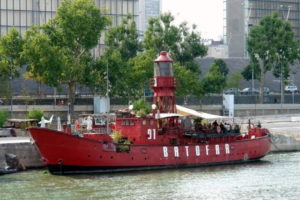
There are quite a number of péniches moored in Paris where you can dine, enjoy a cocktail or party into the small hours. Two of these are Batofar and Petit Bain, moored alongside the Bibliothèque François Mitterand in the 13th arr. Both rock to the beat of hip hop, rock, electro, and various other similar music genres.
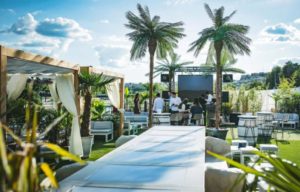
As a complete contrast, Perhaps Péniche Mademoiselle Mouche might have more appeal. Owned by the Bateaux-Mouches company, it’s moored near the Eiffel Tower with the Pont d’Alma on one side and the beautiful Pont Alexandre lll on the other. The views from the terrace alone would be enough a reason to head there.
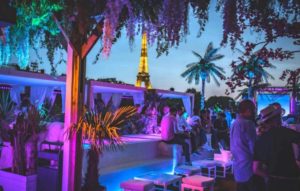
But this rooftop terrace atop the barge is so much more: a flower-filled garden oasis replete with a man-made lawn, where you can lounge on an outdoor sofa or deck chair and soak up a beautiful sunset while sipping a cocktail. Live music and DJ sets take place all summer long, and on weekends Mademoiselle Mouche also offers daytime brunch. Open May to mid-October.
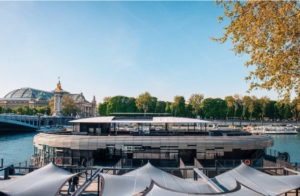
Almost in the same great location, is Péniche Le Flow, just a few steps from Pont Alexandre lll and the Invalides, at 4 Port des Invalides in the 7th arr. A combination smart, modern restaurant that seats 55 people, a bar and concert venue, this swanky spot is always buzzing, thanks to its central location and open-air rooftop, which is open no matter the season. However, in summer, the terrace is especially coveted thanks to its sunny tables with panoramic views of the Eiffel Tower Grand Palais and the beautiful Pont Alexander lll. There’s also a shaded central area offering respite from the sun. You can enjoy cocktails and excellent snacks all year round.
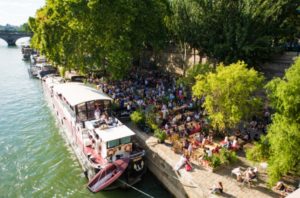
At the foot of the Pont Marie, near the Hotel de Ville and Notre Dame, you’ll find a lovely historic barge, Péniche Marcounet, a 38m long Freycinet-style barge built in 1925. The generous outdoor space is complete with environmentally sensitive plants, natural wines served in eco-friendly glasses and a tapas-style menu that includes locally sourced products. It’s open from morning until midnight, but be sure to arrive early for the evening concerts, which are often free and usually feature jazz or swing music. They also offer a popular Sunday Music Brunch, with several set menus of breakfast favourites—eggs, smoked salmon, freshly baked croissants and other patisserie—accompanied by live music. The terrace is open from May to October, weather permitting.
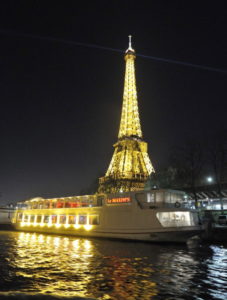
The most luxurious péniche must surely be Le Maxim’s Sur Seine, moored at Port de Suffren on Quai Branly in the 15th arr., further along from the Eiffel Tower. This is certainly a floating palace, with its two tiers decorated in the Belle Epoque style to replicate the celebrated restaurant in Rue Royale. As you’d expect, the food, service and ambience are of the same standard.
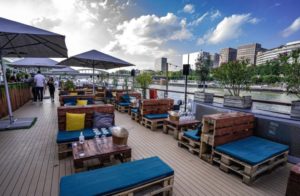
This is just a selection of the péniches waiting to be discovered. Next time you’re in Paris, allow some time to step off dry land and take to the water on some of the city’s coolest stationary péniches.
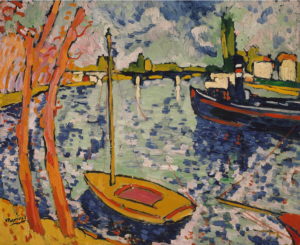
These barges embody the motto of the French capital: “Fluctuart nec mergitur”—“it rocks but never sinks”!


Fascinating as always.
It’s really interesting how many of the peniches lining the river are for such diverse uses nowadays. There are so many more we’d love to check out next time! We still are yet to go to the cinema on the peniche, or see a play. I’ve been curious to find out what it’s like if the weather makes the water a bit rocky!